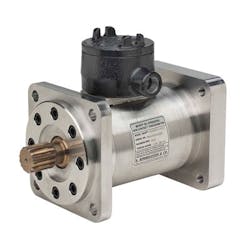New torque meter enables load monitoring during jacking operations
Offshore staff
CHICAGO– S. Himmelstein and Co. has provided an update on its various torque meters.
The MCRT 38569X device measures torque for control and verification of loads on liftboat support legs. It enables load monitoring during jacking operations and helps maintain stability on uneven and shifting sea beds and strong currents.
The device, which has been certified by ABS, has a standard splined shaft and mounting flange configuration which simplifies mounting directly between the hydraulic or electric drive motors and pinion drive gearboxes on each leg’s truss. The system transmits data via a two-wire 4-20 mA loop to the control room.
According to the company, because the torque instrument measures the source load distribution directly it enables a faster response time. This advance warning of any change or movement of weight helps prevent damage to decks and jacking equipment.
The MCRT 38569X torque transmitter measures bidirectional static (stall) and dynamic shaft torque and speed (an option). A one piece stainless shaft carries bonded, foil strain gages. It measures torque, and in combination with element design, will cancel bending and thrust loads.
The company says the bearingless digital torque transducers provide high accuracy, overrange, and overload. The latest models offer best combined non-linearity and hysteresis error of less than ±0.01% of full scale.
Standard features include high mechanical overloads of either 200% or 400%, depending on model, offering a mechanical safety margin in the presence of high startup torques or large torsional oscillations. Substantial overrange of up to 300% on the electrical output signals avoids clipping of real-world torque peaks and driveline torsionals and reduces potential for errors in the average torque measurement.
Wide allowable tolerance in the positioning of the stator relative to the rotor simplifies the user’s installation and protects the equipment from rotor to stator contact due to vibration or thermal growth. They are available in three accuracy grades: ±0.04%, ±0.02% or ±0.01% of full scale combined linearity and hysteresis
In addition, the Series 2300DV reaction style torque transfer standard is ideally suited for non-rotating field calibration of production torque meters.
The sensor will perform as a complete, ultra-precise torque transfer standard without the requirement for a mV/V calibrator or other external device. It allows field calibration of installed torque meters without requiring removal and transfer to a remote torque calibration laboratory.
The torque transfer standard is characterized by high torsional stiffness and low deflection. Multiple bridges and elegant sensor design provide high immunity to clamping and other extraneous loads. High overrange on the electrical output signals avoids errors from clipped torque peaks. High mechanical overload results in significant safety margins and reduces likelihood of damage. They are available in three accuracy grades: ±0.04%, ±0.02% or ±0.01% of full scale combined linearity and hysteresis.
08/12/2016
